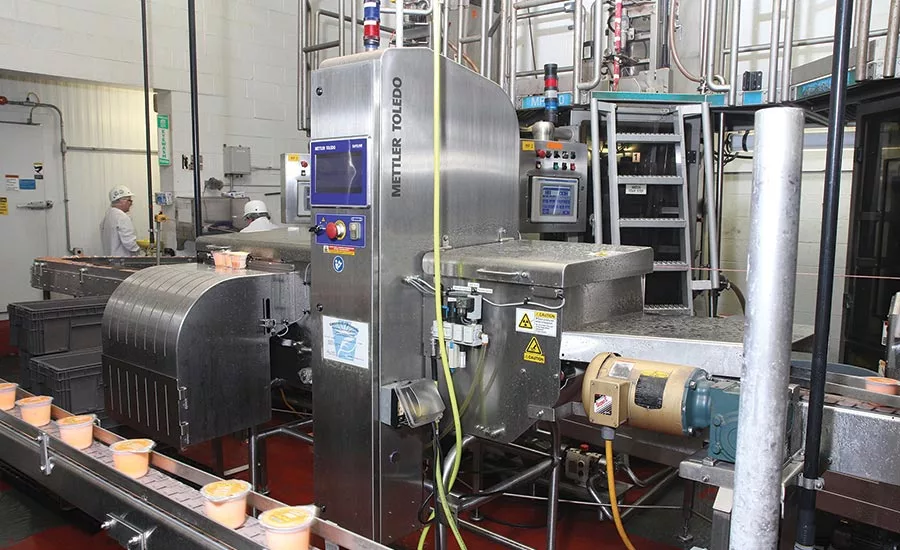Dry Processing
X-ray inspection equipment maximized detection at J&J Snack Foods

J&J Snack Foods uses an X-ray inspection system to ensure that all of their products meet the high quality standards set forth by the company.
Photo courtesy of Mettler Toledo
J&J Snack Foods was established in 1971 when Gerald B. Schreiber bought an ailing pretzel company at a court auction in Pennsauken, N.J. What began as a small pretzel processor has grown into a leading processor of baked goods, frozen beverages and frozen novelty products. Its 4,200 employees across 18 production facilities process 25 house brands—including ICEE, Luigi’s Italian Ice and Tio Pepe’s Churros—as well as customers’ private labels.
Because some packages have foil lids, J&J Snack Foods knew this could be a problem for metal detectors, according to Carissa Chrobak, food safety quality control manager.
“We decided to go with X-ray systems instead of metal detectors on these lines because we wanted to maximize our detection capabilities,” she says. “First, X-rays detect all dense foreign material and automatically reject contaminated packages. Second, some of our packages have foil lids, which is a problem for metal detectors. Finally, we sometimes use our X-rays to inspect the volume of product in a cup or the placement of product components in a package. For example, we have a package for club stores that contains tubes of Italian ice, and X-ray inspection lets us confirm the tubes are oriented correctly.”
The snack food maker was already using Mettler Toledo Safeline equipment, so the team was familiar with the brand and went to its supplier first.
“We have checkweighers and other equipment from Mettler Toledo, so they were our first choice when we decided to install X-rays on a new line and two existing lines here at our Moosic, Pa., facility,” says Ernest Fogle, vice president of research and development, frozen desserts division. “We wanted X-rays that offered impressive sensitivity, ease of use and reliability at an affordable price.”
J&J Snack Foods selected the X36 X-ray system for a mixed product line that produces variety packs. Capable of being designed with up to eight separate lanes for running different products at once, the X36 has two lanes. It inspects similar products, such as different flavors, at the same time on two side-by-side conveyors while keeping the two product types separate. Handling 250 cups per minute, the line inspects Italian ice sorbets, frozen juice and ice cream in 2- or 4-oz. cups with foil lids or 6-oz. cups with paper locking lids. It’s equipped with several options including a Safeline pneumatic reject device, an electronic bin for storing rejected products and a buzzer that alerts the operator when a package is rejected.
The company selected the single-lane X33 X-ray system for each of its two high-throughput frozen dessert and beverage packaging lines. These lines handle a variety of different poly-based cups, ranging in size from 3 to 4.4 oz., at 250 cups per minute. Like the X36 system, they’re equipped with Safeline pneumatic reject devices, electronic bins and alarms.
Both models are designed to achieve the same high-detection sensitivity as their previous-generation SmartChek and AdvanChek models but feature 20-watt generators, which consume one fifth of the power. “We’re constantly looking for ways to minimize the energy we consume in order to reduce our environmental impact and improve our bottom line,” says Jay Montgomery, vice president and general manager at J&J Snack Foods. “These Safeline systems help support our goal to be as green as possible.”
“Since food safety is our top priority, sanitation is always on our minds. We wash down all our lines at least once a day, so our machines need to be easy to clean,” says Henry Anderson, maintenance manager. “In addition to having inherently hygienic designs, our X-ray systems include Safeline’s optional IP65/IP66 enclosures, so electronics stay dry and the equipment runs perfectly, even with our frequent washdowns.”
“All around, the X33 and X36 are very straightforward to use. They feature intuitive touchscreen control panels and preprogrammed settings, which keep it simple for operators. Three levels of password protection prevent low-level employees from accidently changing product recipes,” says Anderson. “These systems require only routine preventative maintenance—we’ve had no unplanned downtime.”
Looking for a reprint of this article?
From high-res PDFs to custom plaques, order your copy today!







